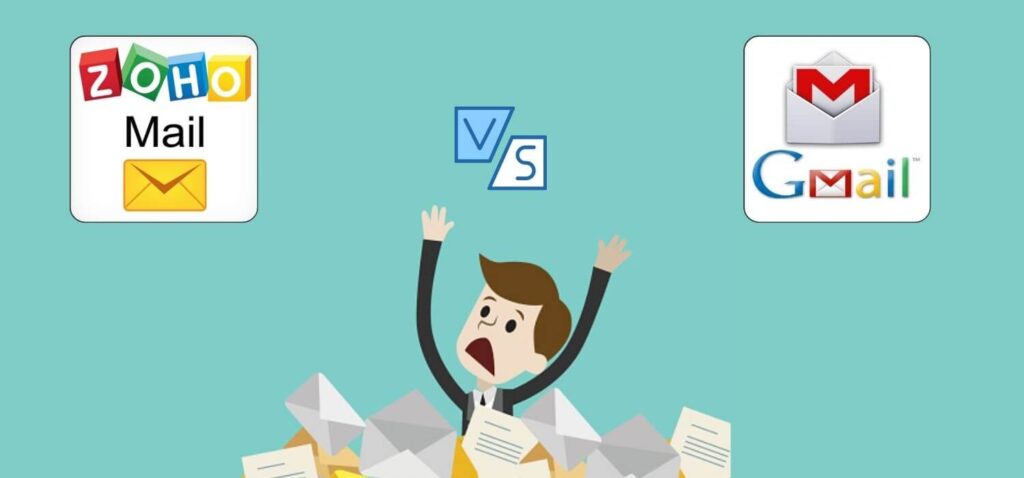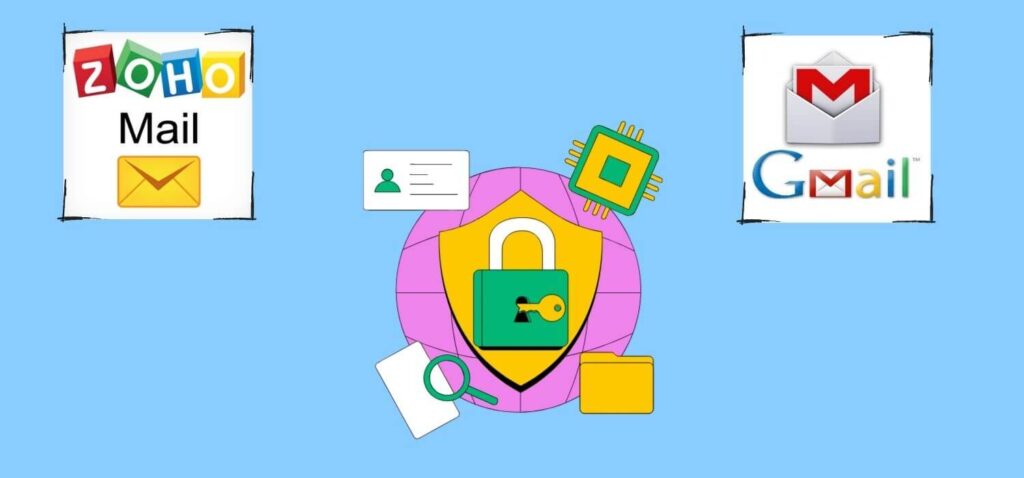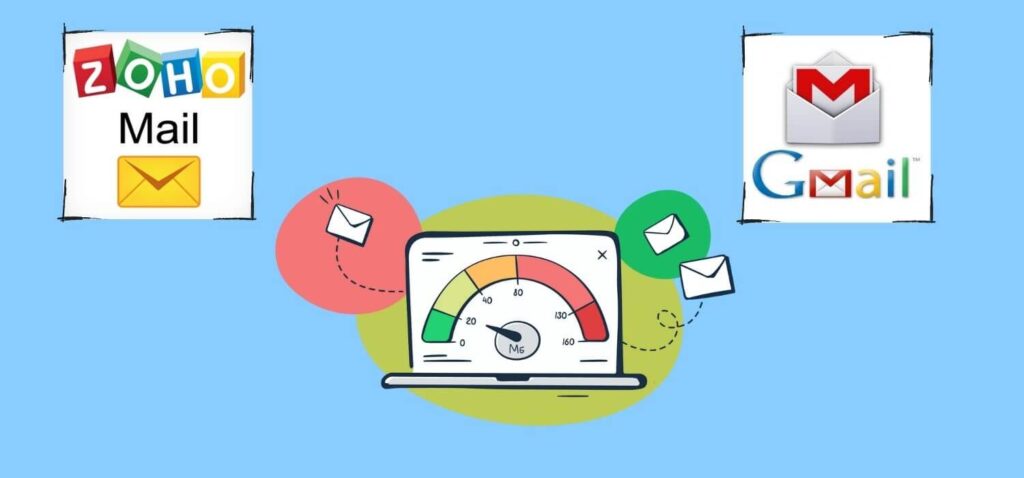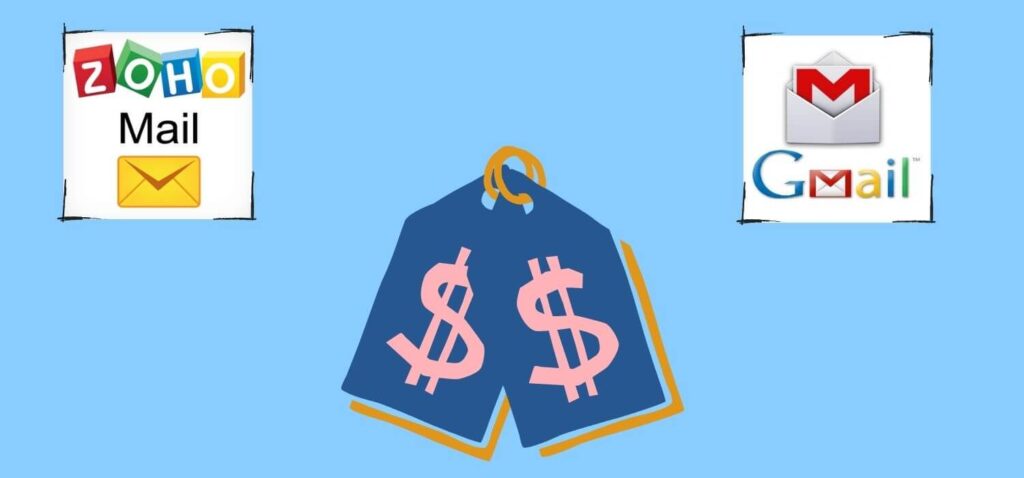When it comes to deciding between Zoho Vs Gmail for your business email service, you’ve probably considered the advantages of each. These two popular options cater to your needs, so let’s delve into the details and compare aspects like features, security, and pricing in order to help you make an informed decision.

User Interface and Features
Zoho Mail:
The user interface of Zoho Mail prioritizes functionality for those who’re already familiar with the Zoho ecosystem. While it may not have the intuitiveness of Gmail, it seamlessly integrates with the Zohos suite of apps, which enhances collaboration and task management. The folder system in Zoho Mail is similar to Gmail’s labels, ensuring consistency across the Zoho ecosystem. This can be particularly beneficial for businesses that utilize Zoho tools.
Zoho Mail offers a range of features that facilitate business communication. Its custom domain functionality adds a touch to your emails, leaving an impression on clients and partners. The integration with Zoho applications promotes a workflow, enabling teams to collaborate efficiently.
The different options for filtering emails are helpful for keeping your inbox organized, and being able to access your emails ensures that you can stay productive without an internet connection.
Gmail:
Gmail stands out because of its user interface, which is known for its navigation. The way Gmail categorizes emails into primary, promotions, social, updates, and forums helps make email management more streamlined. Additionally, Gmail’s integration with Google Workspace tools like Calendar and Tasks makes it a great hub for productivity.
Gmail’s interface includes the known left hand side panel, which makes it easy to organize emails into categories based on their content. These categories. Primary, Promotions, Social, Updates, and Forums Make it easier to manage messages. While Gmail’s filters automatically sort emails, you still have the flexibility to manually move emails between categories if needed. Labels offer customization options by allowing users to apply labels to a single email or organize them hierarchically like a file system structure.
Range of Features
Zoho Mail:
Zoho Mail focuses on integrating within the Zoho ecosystem. Offers unique features like Streams. A comment system similar to social media that enables collaboration within emails. Email Policies provide options for business administrators to manage compliance efficiently. Zoho Mail prioritizes collaboration and efficient management within its ecosystem through its approach to features.
Zoho Mail’s standout feature, Streams, brings media interaction to email by allowing comments, within emails. This innovative feature enhances collaboration by enabling team members to discuss and work on emails together, eliminating the need for forwarding. In addition, Email Policies in Zoho Mail empower business administrators to streamline email communication by implementing group options that ensure compliance with regulations.
Gmail:
On the other hand, Gmail offers users features such as Smart Compose and advanced AI powered spam filters. The integration with Google Workspace further enhances productivity by providing access to tools like Google Calendar and Google Tasks.
Smart Compose in Gmail is a feature that showcases the potential of AI. It suggests sentence completions while composing emails, making the writing process faster for users. Moreover, Gmail’s advanced AI driven spam filters provide security measures compared to competitors by accurately identifying and isolating spam emails.
Security

Zoho Mail:
When it comes to security, the first question that comes to mind is, Is Zoho Mail Legit? Well, as Zoho is one of the top Multinational companies in the world, that question gets an easy answer. But, the second question that comes to mind is – Is Zoho Mail Safe? Zoho Mail prioritizes safeguarding data with features like Two Factor Authentication (2FA) and end to end encryption. This strong focus on email security makes it an ideal choice for businesses concerned about protecting their information.
Zoho Mail demonstrates its commitment to security by implementing features like Two Factor Authentication (2FA), which acts as a defense against unauthorized access. Moreover, they ensure the confidentiality of your email content through end to end encryption, effectively preventing any breaches of information. Zoho Mail’s security arsenal also includes phishing measures that actively detect and prevent phishing attempts.
Gmail:
When it comes to Gmail, they rely on AI algorithms to identify phishing attempts and offer features like Confidential Mode for email communication. They also provide options such as data loss prevention (DLP) and S/MIME encryption in their Enterprise tier to enhance email security.
By leveraging the power of AI, Gmail’s security measures are efficiently implemented. Alert users about phishing threats, thereby enhancing overall email security. Another notable feature is Confidential Mode, which enables the sharing of information through emails that cannot be downloaded, forwarded, printed, or copied. For enterprises using Gmail’s Enterprise tier, advanced security features like data loss prevention (DLP) and S/MIME encryption are available to strengthen email security.
Storage and Attachment Limits

In terms of storage and attachment limits, Zoho Mail and Gmail offer approaches tailored to meet business needs.
Zoho Mail:
Zoho Mail provides a range of plans, with storage capacities that make it suitable for businesses of all sizes. The paid plans offer sizes going up to 1 GB, according to Zoho Mail Review, It’s quite appealing for businesses that often deal with large attachments.
When it comes to storage and attachment limits, Zoho Mail is versatile enough to cater to businesses of varying sizes. They have a variety of plans, from options to paid ones, ensuring They meet diverse requirements. Even the free plan offers an attachment limit of 20 MB, while paid users can enjoy the luxury of attachments as large as 1 GB. This generous capacity for attachments proves beneficial for businesses that frequently exchange files.
Gmail:
On the other hand, Gmail also provides tiers with increasing storage capacities to accommodate both individual users and businesses. While their attachment limits might not be as generous as Zoho Mail’s, they are still sufficient for users.
Gmail’s approach to storage and attachment limits aligns well with its user oriented design philosophy. The free plan offers 15 GB of storage space, ensuring that users have room for their emails. Attachment limits are set at 25 MB, for the plan, which might prompt users to rely on Google Drive when dealing with attachments.
While Gmail’s paid plans increase the limit to 500 MB, it’s important to note that this may not be sufficient, for businesses dealing with large files.
Pricing Structures

Zoho Mail:
Zoho Mail pricing structure provides flexibility, catering to those who only need the email app or the complete Zoho Workplace suite. The plans differ in storage capacity and attachment limits. Included features. Choosing the Zoho Workplace package grants access to a set of productivity tools.
Zoho Mail’s pricing structure reflects their dedication to serving businesses of all sizes and requirements. For those primarily focused on the email app, Zoho Mail offers two plans; Mail Lite and Mail Premium. Mail Lite offers features at a price, while Mail Premium enhances the package with additional storage and encryption capabilities. If you’re seeking a solution, Zoho Workplace provides Standard and Professional plans that encompass a wider range of applications.
Gmail:
Gmail’s pricing tiers range from a free plan with limitations to paid plans that offer higher storage capacities and extra features. Their Enterprise tier emphasizes security measures.
Gmail has designed its pricing model to accommodate both users and businesses alike. The free plan is an option, as it offers enough storage and essential features. For businesses looking for capabilities, there are paid plans available such as Business Starter, Business Standard, and Business Plus. These plans offer levels of storage and advanced features. Furthermore, the Enterprise tier provides a security focused solution, although specific pricing details need to be discussed with Google’s sales team.
The final Verdict
When comparing Zoho Mail and Gmail, both have their strengths. Zoho Mail excels at integrating with the Zoho ecosystem. It offers robust security measures, making it an excellent choice for businesses that prioritize collaboration and data protection. On the other hand, Gmail stands out with its user interface, smooth integration with Google Workspace, and advanced AI driven features that cater to those seeking productivity and innovation.
Choosing between Zoho Mail and Gmail ultimately depends on your business priorities. Whether you value collaboration, an intuitive user experience, or top notch security, it will determine the fit for you. To make a decision tailored to your needs, we recommend consulting experts in the field, such as Customerization. A reputable Canadian based consulting company specializing in Zoho services and CRM consulting. They can provide guidance to help you find the optimal email solution that aligns with your business goals.
If you’re interested in discovering more, you can check out customerization.ca. The customerization team can help improve your business communication and potentially lead to success.
At Customerization, our mission is to empower you to harness the full potential of Zoho’s powerful tools. We believe that with the right guidance and support, you can achieve your business goals more efficiently and effectively. So, whether you have a simple question or a complex project, don’t hesitate to get in touch with us!
Related posts:
No related posts.


